Why Do I Have Icicles Hanging from My Gutters: Causes and Solutions
Icicles hanging from your gutters are more than just a winter ornament; they’re an indication of heat loss in your home and can lead to ice dams, which are problematic. As an expert handyman, we often see icicles as a sign that warm air is escaping from your attic, melting snow on your roof, which then refreezes at the eaves and gutters.
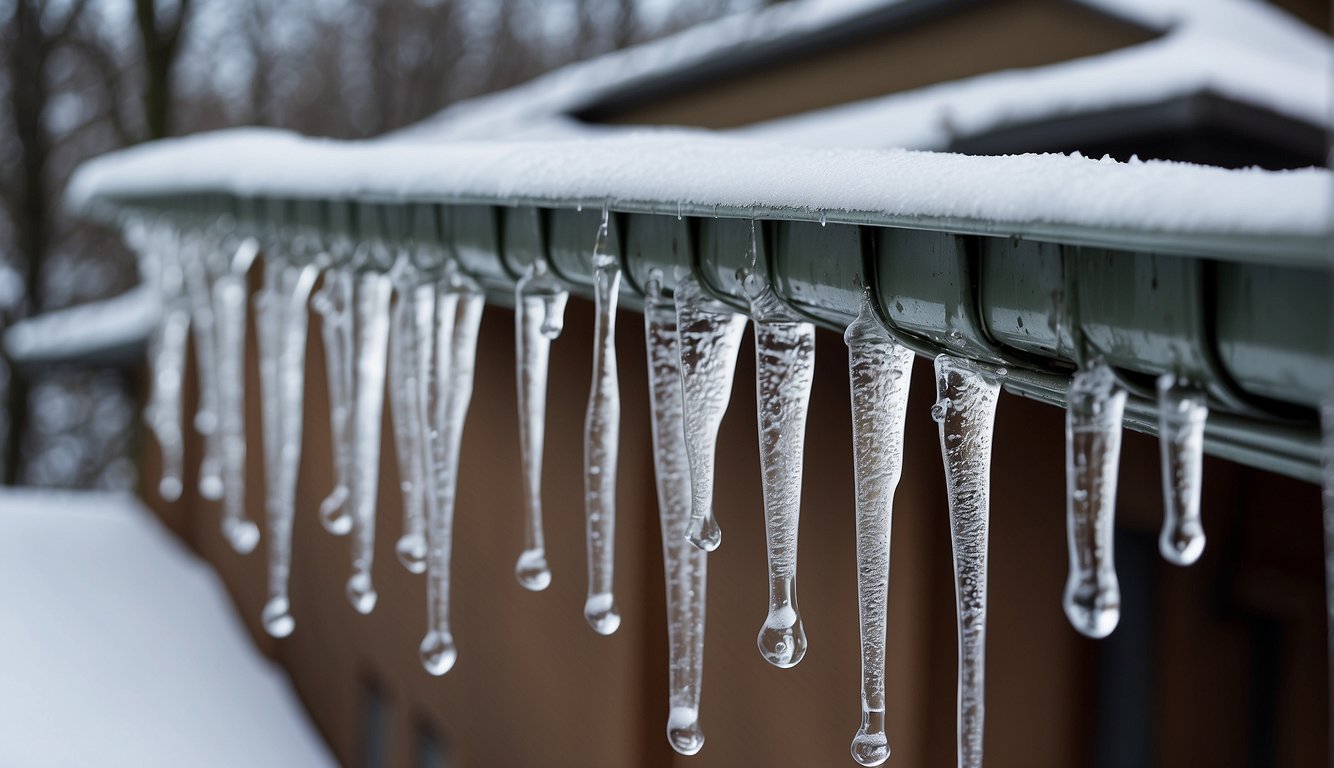
To prevent icicles and the potential of ice dams, it is essential to maintain good insulation and ventilation in your attic. This helps keep the roof temperature uniform and prevents the melt-refreeze cycle that causes icicles to form on the gutters. Additionally, removing snow from the roof with a roof rake and ensuring that gutters and downspouts are clear of debris can diminish the formation of icicles and ice dams. Implementing these measures not only protects your home but also enhances energy efficiency.
Ice Dams and Icicles Formation on Gutters
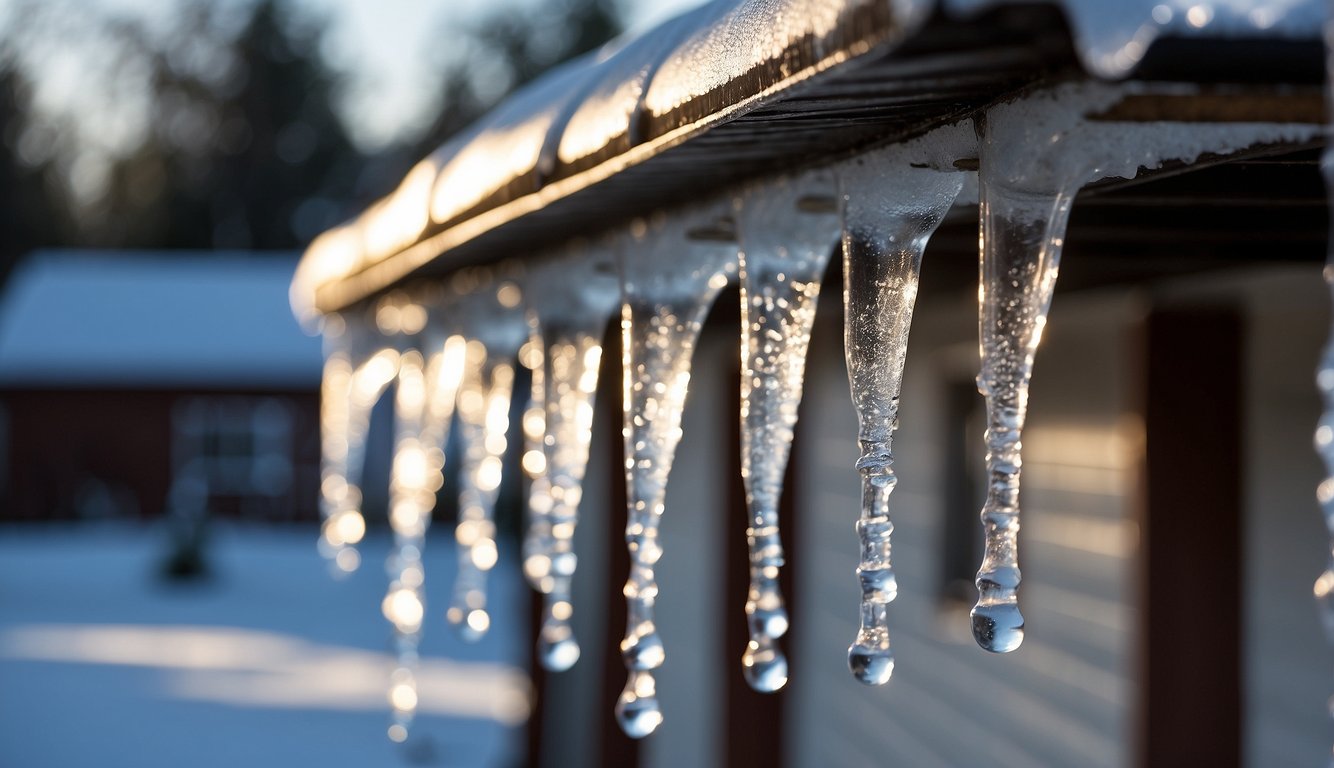
To tackle the issue of icicles dangling from gutters and the formation of ice dams, it’s essential to understand the underlying causes and the resulting strain they can put on your home’s infrastructure.
Causes of Ice Dam Formation
Ice dams occur when warm air escapes from the attic and heats the roof, causing snow to melt. The water runs down the slope to the colder edge and refreezes, creating a ridge of ice that traps more water. Here’s what contributes to this cycle:
- Insulation: Poor attic insulation allows heat to rise, melting the snow on the roof.
- Ventilation: Inadequate ventilation traps warm air in the attic, further exacerbating the problem.
These issues not only facilitate the formation of ice dams but can also lead to water damage in your home, as the trapped water can seep under shingles and into the structure.
Impact of Icicles on Gutters
While icicles may add a wintery charm to your home, they’re a tell-tale sign of potential gutter damage. Below are key impacts:
- Weight: Icicles add significant weight to gutters, which can lead to gutter damage or even detachment.
- Blocked Gutters: The presence of icicles indicates that water is not flowing freely, which can result in backed-up water that exacerbates ice dam formation.
By addressing insulation and ventilation issues in your attic, you can mitigate the formation of ice dams and icicles on your gutters, protecting your home from potential water and structural damage.
Preventing Ice Dams and Icicles on Gutters
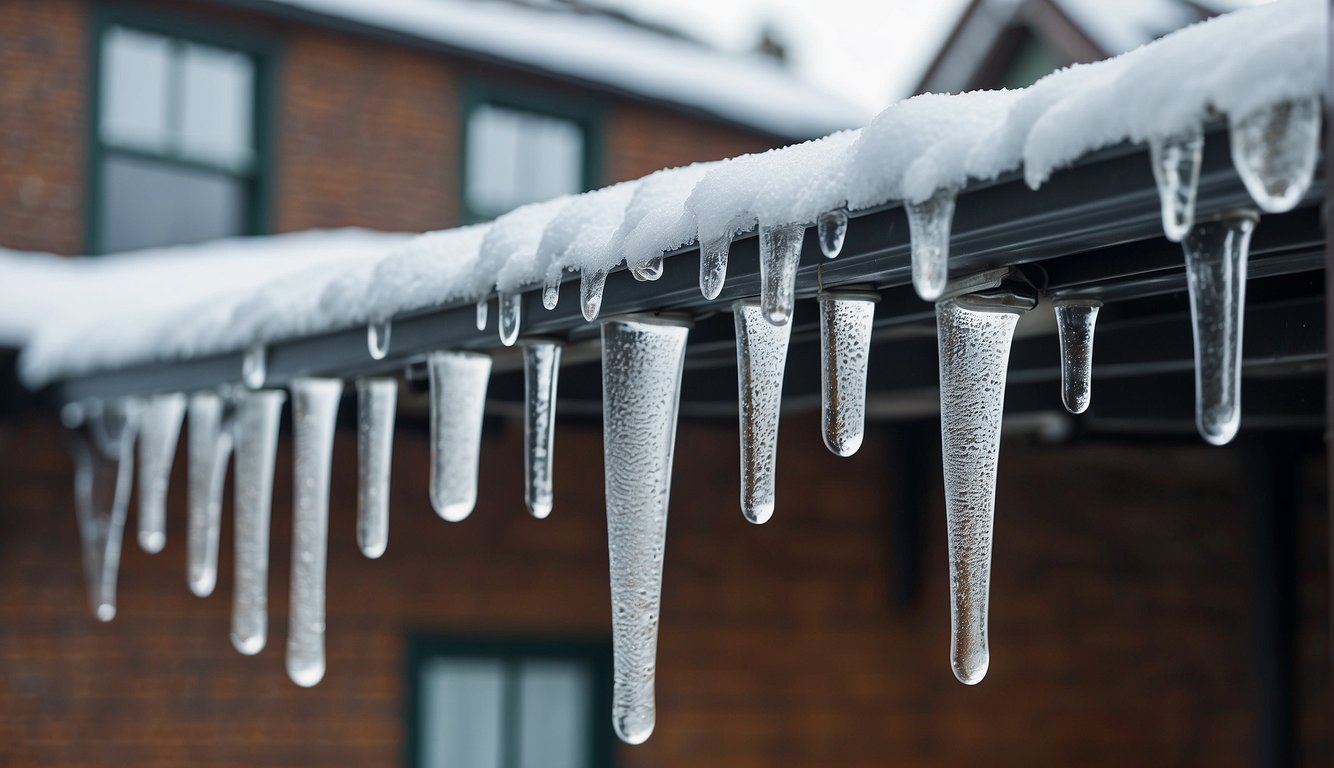
To keep our homes safe and efficient during winter, it’s essential to prevent ice dams and icicles from forming. Taking proactive steps can save us from potential leaks and structural damages to our gutters and roofs.
Improving Attic Insulation
Insulating our attic is the number one defense against ice dams. Ensuring we use quality insulation materials like fiberglass or cellulose can maintain warmth in the living spaces below without overheating the roof. The optimal insulation level varies, but most homes benefit from an R-value between R-30 and R-60.
- Fiberglass Insulation: Effective, non-flammable, and relatively easy to install.
- Cellulose Insulation: Made from recycled paper; it also provides good insulation.
Enhancing Roof Ventilation
Proper ventilation helps regulate attic temperatures and prevents snow from melting and refreezing at the edges. We should aim for a balance between air intake and outflow, utilizing soffit vents, ridge vents, or gable vents.
- Soffit Vents: Allow cool air to enter at the eaves.
- Ridge Vents: Release hot air at the top of our attic.
Proper Gutter Maintenance
Maintaining clean gutters and installing gutter guards can be key in preventing ice build-up. A clean, smoothly flowing gutter system ensures melting snow can drain off the roof instead of forming icicles.
- Regular Cleaning: Prevents clogs from leaves and debris.
- Gutter Guards: Keep debris out and reduce the need for cleaning.
Safe Ice Dam and Icicle Removal
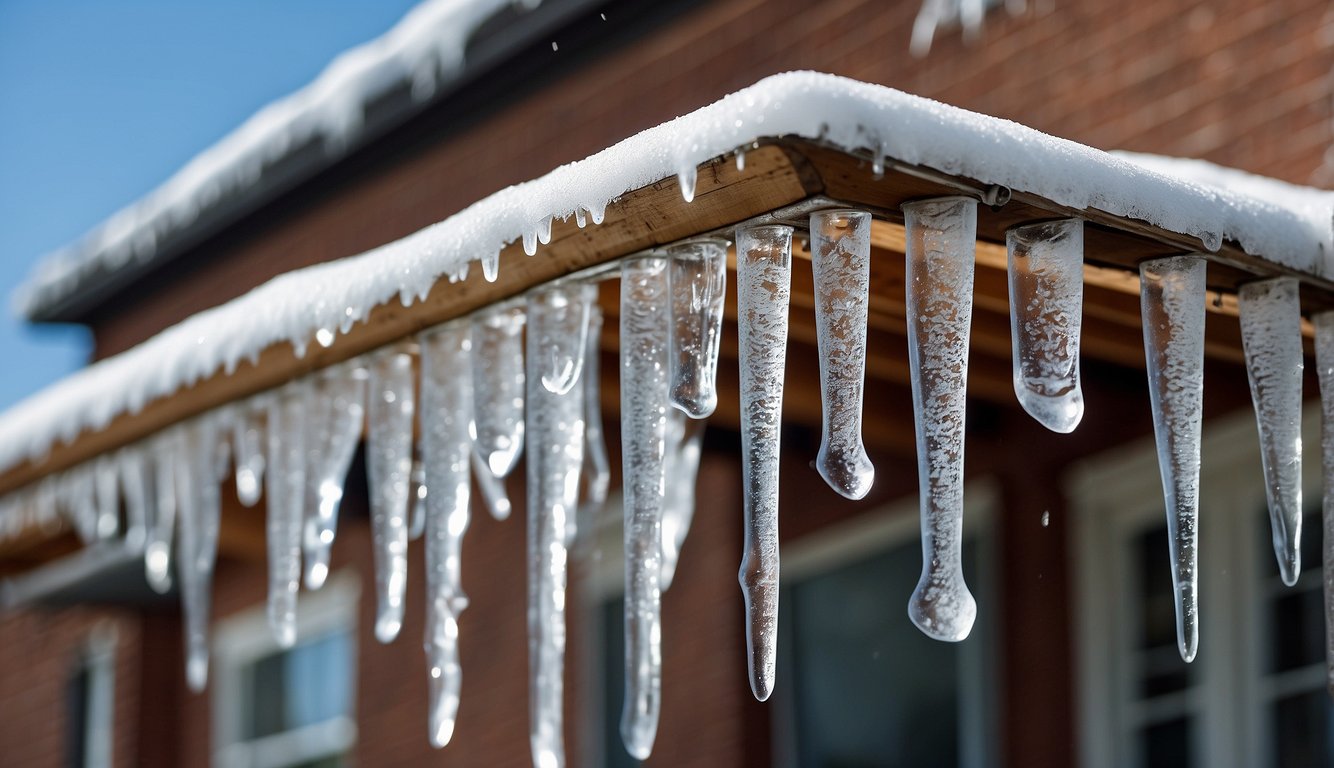
When tackling ice dams and icicles, safety is paramount. We’ll use the right tools and techniques to prevent injury and avoid causing damage to the roof.
Using a Roof Rake
Steps for Proper Usage:
- Stand on the ground and reach up with the roof rake, avoiding any direct contact with the roof’s surface.
- Gently pull the snow down off the roof to prevent ice dam formation.
Important Note: Do not use excessive force, as it may damage the roof shingles.
Applying Ice Melt Products
Correct Application:
- Fill a pair of pantyhose with calcium chloride ice melter.
- Lay the filled pantyhose perpendicular to the ice dam in the gutter.
Key Points:
- Calcium chloride is preferential over rock salt as it’s less damaging to the roof and vegetation.
- Never use rock salt or sodium chloride, which can damage both the roof and the plants below.
Professional Removal Services
When the situation seems challenging or dangerous, seeking professional removal services is recommended.
Advantages of Hiring Professionals:
- Expertise: They know how to safely remove ice without causing damage.
- Equipment: Professionals use specialized tools and techniques.
Considerations for Safety:
- Ensure the service provider has good reviews and proper insurance.
- Professionals are better-equipped to handle the inherent safety hazards of working on a roof, especially with heavy snow accumulation.
By using these methods, we can effectively and safely deal with ice dams and icicles. Always prioritize safety and consider calling on professionals if the task is beyond our expertise or if there’s a risk of injury.
Protecting Your Home from Water Damage
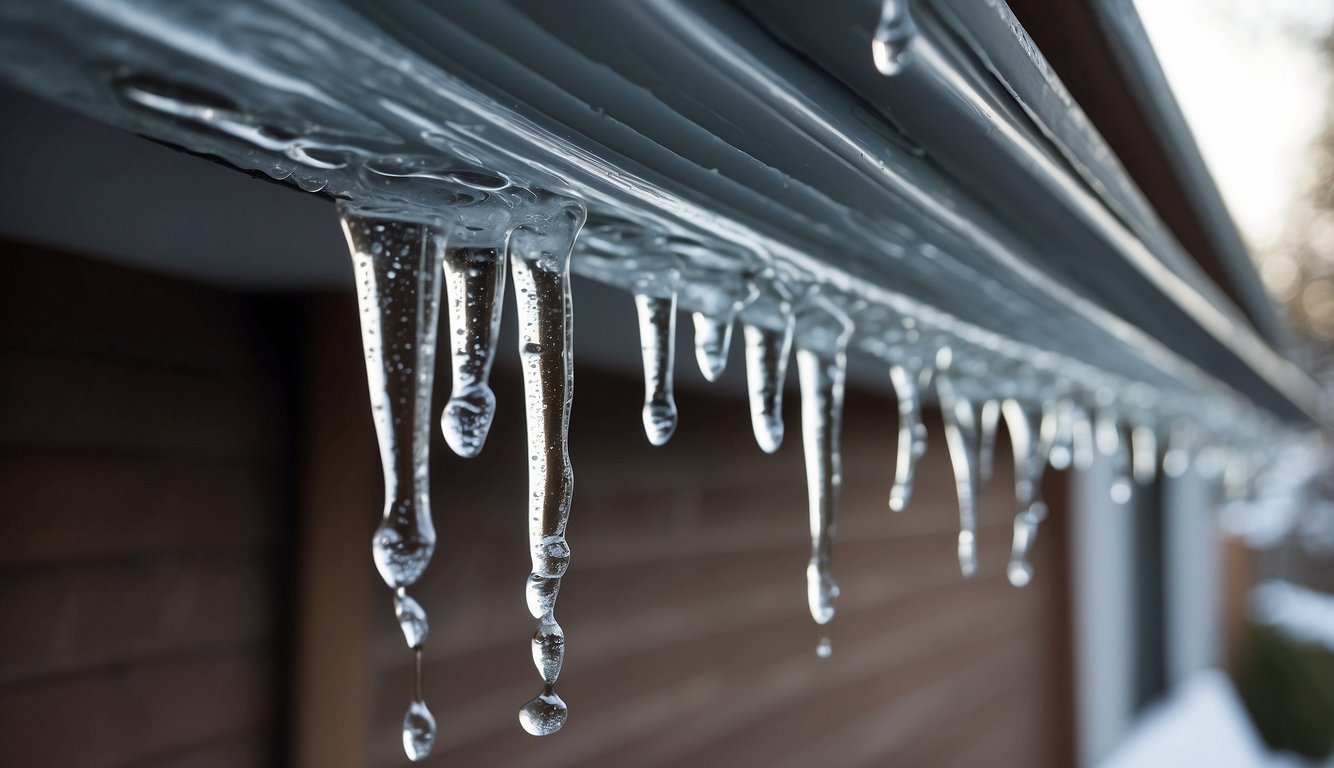
Water damage to your home can be costly and lead to mold growth. Preventing leaks from ice dams and icicles is key to ensuring the integrity of your roof and the comfort of your living space.
Sealing and Insulating the Attic
Proper attic insulation and sealing are critical to prevent warm air from melting snow on the roof, which can lead to ice dam formation. Insulation should be evenly spread and maintain a consistent R-value, which helps in keeping the heat inside your living spaces and out of the attic. Seal any gaps around light fixtures, vent pipes, and chimney flues to prevent warm air leaks.
Installing Gutter Guards and Heating Cables
Gutter guards serve a dual purpose; they prevent debris from clogging gutters and reduce the chances of water pooling and freezing. We recommend heated gutter guards, which further prevent ice formation. If you’re experiencing severe icicle formation, it may be wise to install heating cables along the edges of the roof where ice dams commonly form. These cables provide enough heat to prevent ice from forming without damaging your shingles or roof.
To properly select and install these measures, ensure you follow manufacturer guidelines and local building codes. Regular maintenance and checks are important to ensure these systems remain effective.
Recognizing the Dangers of Icicles
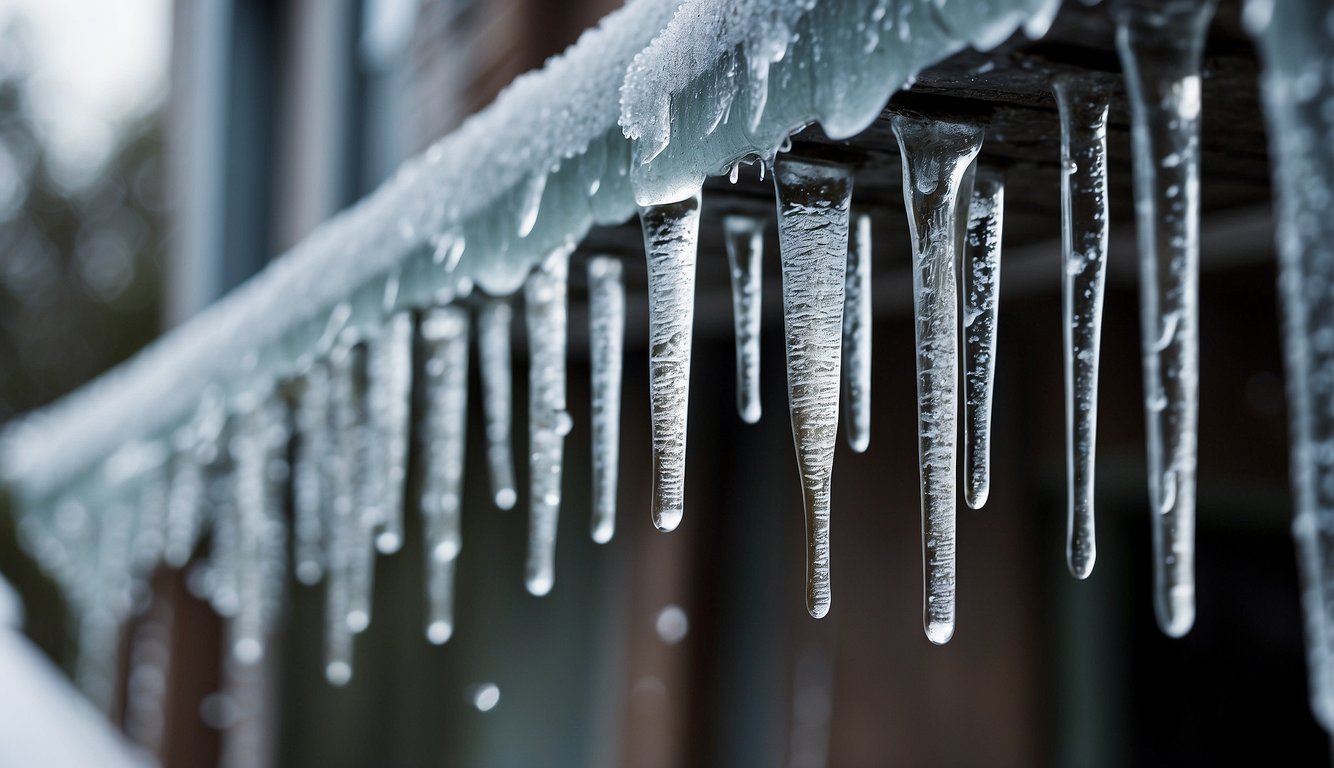
When we see icicles hanging from our gutters, it is often a signal that there’s a larger issue at play. Icicles can pose a threat to our safety and the structural integrity of our homes.
Physical Threat to People and Pets
Icicles can become quite heavy as they form, and their sharp nature makes them dangerous. If they fall, they might cause injury to people or pets passing below. The weight of the ice can be significant enough to cause serious harm upon impact.
- Hazards:
- Injury to passersby due to falling icicles.
- Pets at risk of injury under eaves and gutters.
Risk of Structural Damage
The same weight that threatens personal safety also poses a risk of structural damage to our homes. Icicles can lead to:
- Gutter Damage: Excessive weight can pull gutters away from the fascia.
- Roof Damage: Ice buildup can cause water to back up under shingles, risking drywall and internal structure damage.
- Fascia Wear: The force of heavy ice can tear at the fascia, the board that the gutter is attached to.
| Structural Element | Potential Damage | Cause |
|---|---|---|
| Gutters | Bending or tearing | Weight of the ice |
| Fascia | Pulling away or tear | Ice expansion and load |
| Roofing | Leakage, damages | Ice dams |
As we monitor our homes during the cold months, it’s crucial to keep an eye out for icicles and understand their implications.
Let Us Know How We’re Doing!
Did this expertly prepared resource answer your question?
Do you have another question about home maintenance, home improvement projects, home appliance repair, or something else?
Get more information, send in questions and keep the discussion going by contacting the I’ll Just Fix It Myself company customer service team at at 1-800-928-1490 or Email us at [email protected]
